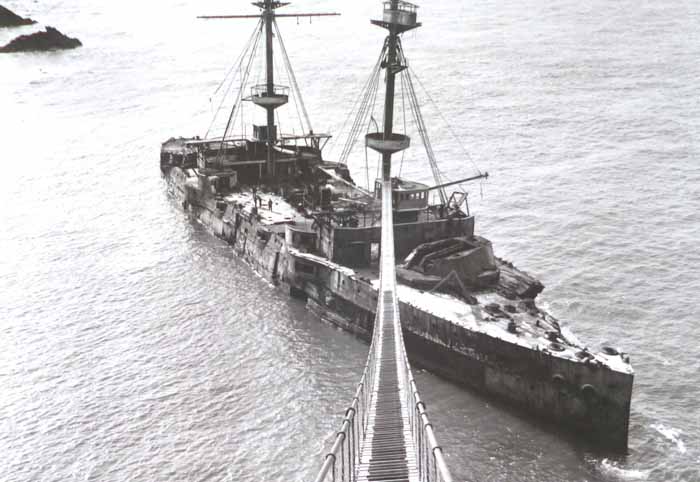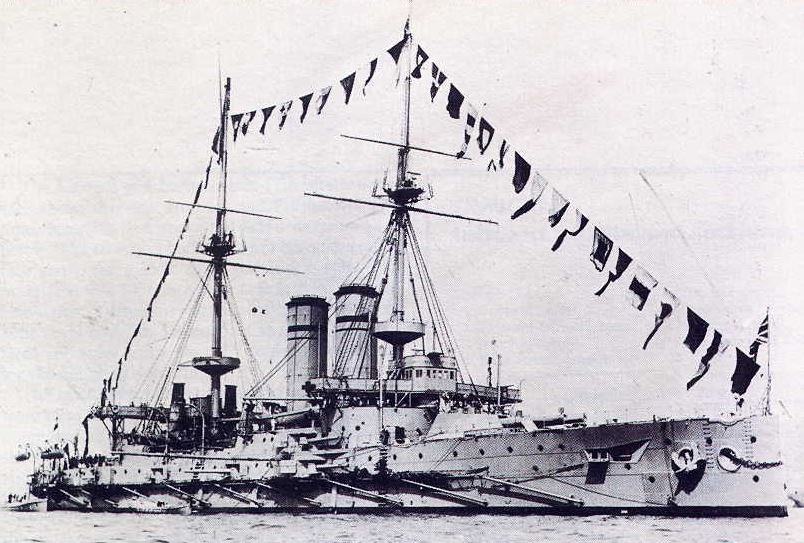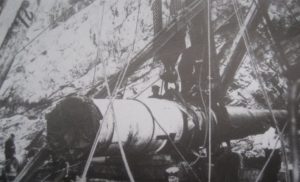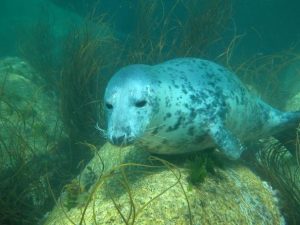HMS Montagu 1901
51°09'57N - 04°40'40W


HMS Montagu was a Duncan-class pre-dreadnought battleship of the British Royal Navy. In May 1906 in thick fog, she was wrecked on Lundy Island, without loss of life. Although she would soon have been obsolescent if she had not been wrecked, this loss of one of its newest battleships was a blow to the Royal Navy, then in the early stages of the naval arms race with Germany.
HMS Montagu was a Duncan-class pre-dreadnought battleship of the British Royal Navy. In May 1906 in thick fog, she was wrecked on Lundy Island, without loss of life. Although she would soon have been obsolescent if she had not been wrecked, this loss of one of its newest battleships was a blow to the Royal Navy, then in the early stages of the naval arms race with Germany
At 0200 hours on 30 May 1906 during radio communication trials carried out in thick fog, Montagu was steaming at high speed in the Bristol Channel when she ran into Shutter Rock on the southwest corner of Lundy Island. The force of impact was so great that her foremast was raked forward. The ship settled hard aground, with many holes in her hull, the worst of which was a 91-foot-long (28-meter-long) gash in her starboard side.
A pilot cutter cruising in the vicinity of Lundy Island had encountered Montagu a short time earlier. The battleship had stopped engines, come abreast, and hailed from the bridge requesting a distance and bearing for Hartland Point on the mainland of England. Though the cutter supplied these accurately, the voice from the battleship’s bridge replied that they must be wrong and that the pilot cutter must have lost her bearings. As Montagu restarted her engines and began to move ahead, the cutter shouted back that on her present course Montagu would be on Shutter Rock within ten minutes, and a short time later the sound of the battleship running aground carried through the fog.
The battleship’s captain, believing Montagu was aground at Hartland Point, sent a party on a rowing boat to the north, instructing them to contact the Hartland Point Lighthouse. They instead got to the North light on Lundy Island, where officers asked the lighthouse keeper to inform the British Admiralty that they were aground south of Hartland Point. An argument ensued with the keeper over where they were until he pointed out he knew what lighthouse he kept.
The court martial convened for the affair blamed the thick fog and faulty navigation for the wreck, and her commanding officer, Thomas B. S. Adair, and navigating officer, Lieutenant J. H. Dathan, were severely reprimanded and “dismissed the ship”, with Dathan losing two years’ seniority.
 The Royal Navy had no experience of salvage and no salvage arm. They had been impressed by the Russian success in recovering major warships damaged at the Battle of Port Arthur and had studied a book by Frederick Young of the Liverpool Salvage Company, later to become Commodore Sir Frederic Young, the Admiralty’s first Chief Salvage Officer. The commander of the Channel fleet, Admiral Sir Arthur Wilson, took charge of the operation with Young appointed as advisor. Young’s son later claimed that Wilson’s salvage plans were “wrong, impractical or both”. From June through August 1906, Montagu was lightened through the removal of her 12-inch (305 mm) and 6-inch (152 mm) guns, heavy machinery, parts of her boilers, heavy fittings, and some of her bow armour. Neither pumping nor attempts to blow water out of her machinery spaces using compressed air had any effect, and nothing that salvage experts tried succeeded in re-floating the ship. Her sister ship Duncan herself ran aground whilst trying to help the salvage effort.
The Royal Navy had no experience of salvage and no salvage arm. They had been impressed by the Russian success in recovering major warships damaged at the Battle of Port Arthur and had studied a book by Frederick Young of the Liverpool Salvage Company, later to become Commodore Sir Frederic Young, the Admiralty’s first Chief Salvage Officer. The commander of the Channel fleet, Admiral Sir Arthur Wilson, took charge of the operation with Young appointed as advisor. Young’s son later claimed that Wilson’s salvage plans were “wrong, impractical or both”. From June through August 1906, Montagu was lightened through the removal of her 12-inch (305 mm) and 6-inch (152 mm) guns, heavy machinery, parts of her boilers, heavy fittings, and some of her bow armour. Neither pumping nor attempts to blow water out of her machinery spaces using compressed air had any effect, and nothing that salvage experts tried succeeded in re-floating the ship. Her sister ship Duncan herself ran aground whilst trying to help the salvage effort.
Today the Montagu is very broken up and has been heavy salvaged over the years.
 You are likely to encounter one of these it you dive the wreck.
You are likely to encounter one of these it you dive the wreck.
Builder: Devonport Dockyard
Cost: £1,046,992
Laid down: 23 November 1899
Launched: 5 March 1901
Christened: Lady Charles Scott
Commissioned: 28 July 1903
Displacement:
13,270 to 13,745 tons load
14,900 to 15,200 tons deep
Length: 432 ft (131.7 m) overall
Beam: 75 ft 6 in (23.0 m)
Draught: 25 ft 9 in (7.8 m)
Propulsion:
24 Belleville water tube boilers
4-cylinder triple expansion
2 shafts[3]
18,000 ihp (13,000 kW)
Speed: 19 kn (35 km/h; 22 mph)
Range: 7,000 nautical miles (13,000 km; 8,100 mi) at 10 knots (19 km/h; 12 mph)
Complement: 720 officers and men
Armament:
4 × BL 12-inch (305 mm) Mk IX guns
12 × BL 6-inch (152 mm) Mk VII guns
10 × QF 12-pounder (76 mm) guns
6 × QF 3-pounder (47 mm) guns
2 × machine guns
4 × 18-inch (450 mm) torpedo tubes (submerged)
Armour:
Belt: 7 in (178 mm)
Bulkheads: 11–7 in (279–178 mm)
Decks: 2–1 in (51–25 mm)
Gun houses: 10–8 in (254–203 mm)
Barbettes: 11–4 in (279–102 mm)
Casemates: 6 in (152 mm)
Conning tower: 12 in (305 mm)